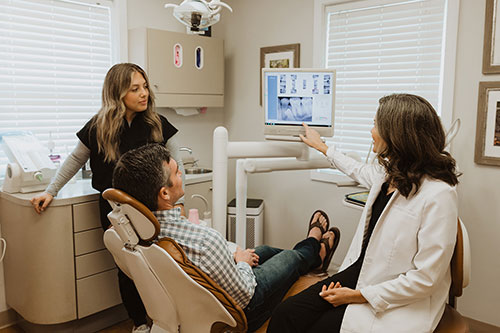Our Technology
Dentist Haddonfield, NJ
 The field of dentistry has been undergoing significant transformation in recent years. Thanks to technological advancements in the industry, dental practitioners today can deliver treatment modalities considered impossible only a few decades ago. From state-of-the-art diagnostic tools to 3D imaging machines, these technologies improve operational efficiency and help deliver better patient care.
The field of dentistry has been undergoing significant transformation in recent years. Thanks to technological advancements in the industry, dental practitioners today can deliver treatment modalities considered impossible only a few decades ago. From state-of-the-art diagnostic tools to 3D imaging machines, these technologies improve operational efficiency and help deliver better patient care.
EXPLORING THE LATEST ADVANCES IN DENTAL TECHNOLOGY
At Cleary Dental, we leverage the latest digital technologies to provide comfortable and safe procedures and treatment options for our patients. We also guarantee swift service delivery and minimal downtimes so you can resume your normal activities.
HOW DIGITAL IMAGING TRANSFORMS DENTAL DIAGNOSTICS
Diagnostics have always been a crucial aspect of dentistry. They allow dental practitioners to detect oral and dental issues and develop effective treatment plans. In the past, dental diagnostics was primarily driven by manual examinations and 2D radiographs. However, the digital era has introduced advanced diagnostic possibilities in the form of digital imaging technologies.
Unlike traditional radiographs that rely on film to capture dental images, modern digital imaging systems use sensors that instantly capture and display images on a computer screen. The immediacy of digital imaging technologies significantly speeds up the diagnostic process. It also makes enhanced image manipulation actions like color differentiation and light adjustment possible, increasing diagnostic accuracy. Some digital imaging tools that are revolutionizing the diagnostic process in dentistry include digital radiography, cone beam computed tomography, and digital impressions. Below, we describe these in further detail.
DIGITAL RADIOGRAPHY
Digital Radiography (DR) is a digital imaging technique that employs digital sensors to capture images of the mouth. The two common types of DR used in modern dentistry are intraoral and extraoral digital radiography. The former captures images inside the mouth, while the latter takes images outside. This technology is slowly phasing out conventional X-rays of the mouth.
CONE BEAM COMPUTED TOMOGRAPHY
Cone Beam Computed Tomography, or CBCT, is an advanced type of digital imaging that produces 3D images of the jawbone, teeth, and soft tissue. It is commonly used in dental procedures such as dental implants and veneers. The specialists we work closely with utilize this technology to provide you with the highest quality of care.
DIGITAL IMPRESSIONS
Gone are the days when dental molds were the only method to create dental impressions. Digital impression systems use optical scanning technology to create 3D renderings of your teeth. These modern dental impressions can be used for orthodontics, crown design, and more.
EXPERIENCE QUALITY CARE WITH THE BEST IN DENTAL TECHNOLOGY
With innovative dental technologies emerging every day, the future of dentistry certainly looks brighter than ever. Thanks to digital technologies and modalities such as digital imaging, 3D printing, and laser dentistry, patients today can enjoy painless and safe procedures and aftercare. At Cleary Dental, we are committed to staying abreast of technological advancements in the dental field. We use the latest technology when diagnosing, treating, and monitoring patient progress after treatment or during checkups. Visit our dental clinic today, or call us at (856) 428-3050 to schedule a consultation with one of our resident dentists.
